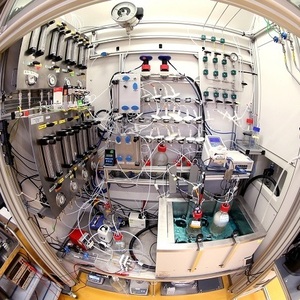Evonik, Siemens to make chemicals from CO2, eco-electricity

Photo: Evonik Corp.
January 19, 2018
BY Evonik Corp.
Evonik and Siemens are planning to use electricity from renewable sources and bacteria to convert carbon dioxide (CO2) into specialty chemicals. The two companies are working on electrolysis and fermentation processes in a joint research project called Rheticus. The project was launched Jan. 18 and is due to run for two years. The first test plant is scheduled to go on stream by 2021 at the Evonik facility in Marl, Germany, which produces chemicals such as butanol and hexanol, both feedstocks for special plastics and food supplements, for example. The next stage could see a plant with a production capacity of up to 20,000 metric tons a year. There is also potential to manufacture other specialty chemicals or fuels. Some 20 scientists from the two companies are involved in the project.
“We are developing a platform that will allow us to produce chemical products in a much more cost-effective and environmentally friendly way than we do today,” said Günter Schmid, technical project responsible of Siemens Corporate Technology. “Using our platform, operators will in future be able to scale their plants to suit their needs.” The new technology combines multiple benefits. It not only enables chemicals to be produced sustainably, it also serves as an energy store, can respond to power fluctuations and help stabilize the grid. Rheticus is linked to the Kopernikus Initiative for the energy transition in Germany, which is seeking new solutions to restructure the energy system. The Rheticus project will receive 2.8 million euros in funding from Germany’s Federal Ministry of Education and Research (BMBF).
“With the Rheticus platform, we want to demonstrate that artificial photosynthesis is feasible,” added Thomas Haas, who is responsible for the project in Evonik’s strategic research department Creavis. Artificial photosynthesis is where CO2 and water are converted into chemicals using a combination of chemical and biological steps, in a process similar to how leaves use chlorophyll and enzymes to synthesize glucose.
Siemens and Evonik are each contributing their own core competencies to this research collaboration. Siemens is providing the electrolysis technology, which is used in the first step to convert CO2 and water into hydrogen and carbon monoxide (CO) using electricity. Evonik is contributing the fermentation process, converting gases containing CO into useful products by metabolic processes with the aid of special microorganisms. In the Rheticus project, these two steps—electrolysis and fermentation—are scaled up from the laboratory and combined in a technical test facility.
“Rheticus brings together the expertise of Evonik and Siemens,” said Karl Eugen Hutmacher from the BMBF. “This research project shows how we are applying the Power-to-X idea.” Using electricity to generate chemicals is an idea from the Power-to-X concept. As one of the four pillars of the Kopernikus Initiative, the idea is to help convert and store renewable, electrical energy efficiently. At the same time, the Rheticus platform also contributes to the reduction of CO2 levels in the atmosphere, as it uses CO2 as a raw material. Three tons of carbon dioxide would be needed to produce one ton of butanol, for example.
Evonik and Siemens see great future potential in the Rheticus platform. It will make it simple to scale plants to the desired size—the chemical industry will be able to adapt them flexibly to local conditions. In the future, they could be installed anywhere where there is a source of CO2—power plant waste gas or biogas, for instance.
“Its modular nature and flexibility in terms of location, raw material sources and products manufactured make the new platform attractive for the specialty chemicals industry in particular,” Haas said. “We are confident that other companies will use the platform and integrate it with their own modules to manufacture their chemical products,” Schmid added.
Advertisement
Advertisement
Related Stories
Luxury North Dakota FBO, Overland Aviation—together with leading independent fuel supplier, Avfuel Corp.— on May 19 announced it accepted a 8,000-gallon delivery of sustainable aviation fuel (SAF) on May 12.
May 21 marks the official launch of the American Alliance for Biomanufacturing (AAB), a new coalition of industry leaders committed to advancing U.S. leadership in biomanufacturing innovation, competitiveness, and resilience.
Neste and FedEx, the world’s largest express cargo airline, have agreed on the supply of 8,800 metric tons (more than 3 million gallons) of blended Neste MY Sustainable Aviation Fuel to FedEx at Los Angeles International Airport (LAX).
The U.S. EPA on May 14 delivered two RFS rulemakings to the White House OMB, beginning the interagency review process. One rule focuses on RFS RVOs and the other focuses on a partial waiver of the 2024 cellulosic RVO.
The U.S. EPA on May 15 released data showing nearly 1.79 billion RINs were generated under the RFS in April, down from 2.09 million generated during the same month of last year. Total RIN generation for the first four months of 2025 was 7.12 billion.
Upcoming Events










